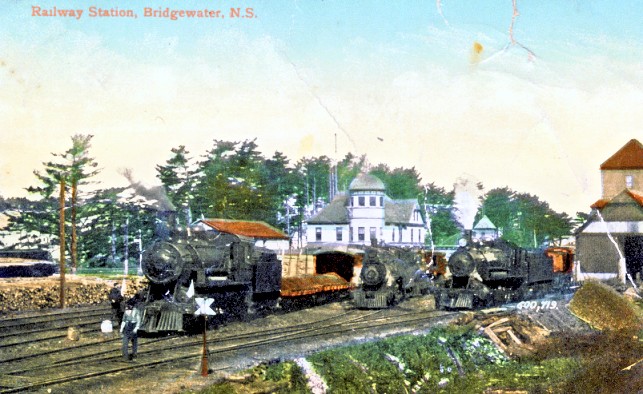
In August 1912, this postcard travelled from Isaac's Harbour, to Guysborough, Nova Scotia.
It shows the Halifax and Southwestern Railway station at Bridgewater, Nova Scotia - just west of Lunenberg.
This railway was part of Mackenzie and Mann's Nova Scotia system between Halifax and Yarmouth along the southern coast.
Bridgewater was also the junction point for the Nova Scotia Central Railway which travelled overland to the Bay of Fundy.
The Canadian Northern soon ceded these two railways to Canadian National Railways management.

The CNR Bridgewater station as it appeared during our Maritime vacation trip in September 1980.
The unique station was destroyed by fire in December 1982 and the railway was gone by the mid-1990s.
The same old battles

This is evidently how they celebrated 100 years ago - before Paul McCartney played the Plaines in 2008.
Note the iron fence topped with spikes around the base of the Wolfe Monument.
In 2008, there was isolated Separatist squeaking about the humiliation of having another British Conquest of the battleground.
Had they never observed the rejuvenating qualities of the beloved Beatles music on Baby Boom age pur laine Quebecois ?
Talk about Two Solitudes !
Illustrating both ... the dangers of celebrity knowledge and advice... and the appearance of today's Canada to an outsider ...
Sir Paul told a francophone network reporter during a damage controlling pool interview conducted in English :
[Some Quebecois are upset ?] 'But you won!' [i.e. you successfully repelled the British]
Ultimately, the sole complaint about the concert was that there weren't enough shuttle buses afterwards to clear the battlefield.
At least tell me the bridge is real !

This postcard travelled to London, England in June 1910.
Through the magic of a postcard artist ....
a CPR train is crossing the St. Lawrence from the future Ville LaSalle on Montreal Island ...
to the CPR railway line leading to points east including Saint John, New Brunswick.
A shallow draft steamboat is about to run the Lachine Rapids of the St. Lawrence as it approaches Montreal.
In the foreground, a raft of timber for export, staffed by the always jaunty francophone 'Raftsmen' also travels the river.
Sleeping and eating quarters and a mast for a sail can be seen in the raft illustration.
Let me think ...
To go west ... first you go north ... then you go south.

This station was opened at the same time as the Grand Trunk's Chateau Laurier in 1912.
At the time, the CPR still preferred its Broad Street station near today's War Museum.
Serving initially as the Grand Trunk's stub-end station,
it was connected by pedestrian tunnel to the Grand Trunk's Chateau Laurier Hotel.
You can see office windows behind the columns.
The Canadian Board of Transport Commissioners was housed in some of the station's office space.
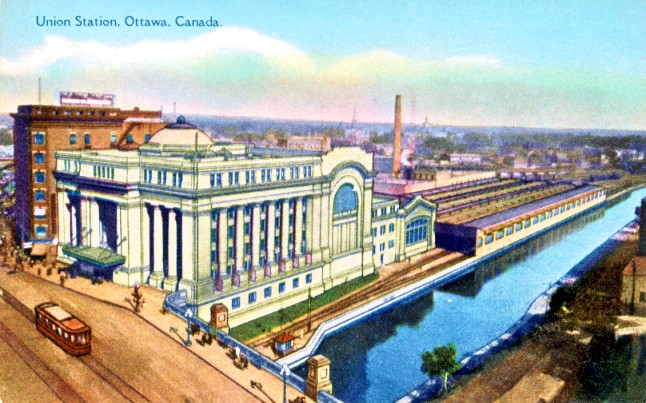
When the CPR moved its passenger station operations to this location, the CPR 'run through' tracks were enclosed beside the canal ...
to shelter Ottawa passengers and other passenger train operations from the weather.
The original Grand Trunk 'train shed' (sheltered passenger tracks) and terminal shops can be seen closer to the smokestack.
Notice the signals and operator's office at the 'control point' switch where the two CPR tracks converge.
Ottawa photos above face roughly south.
Ottawa photos below face roughly north.
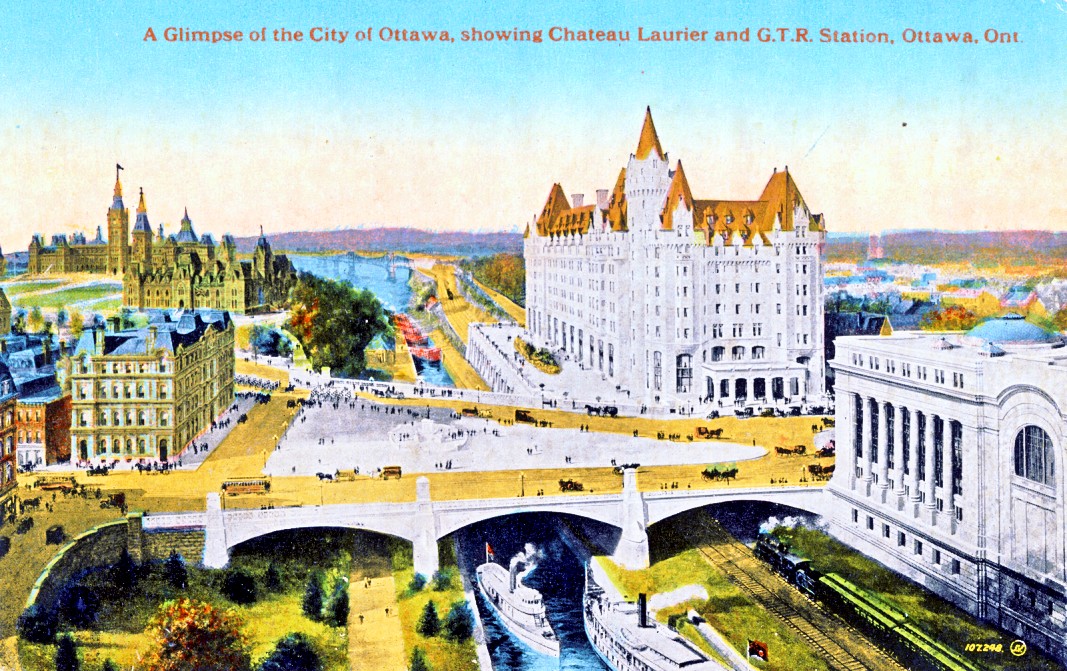
From the right foreground : Station, Chateau Laurier, Quebec on the horizon to the north.
A train departs the station, running north toward Quebec.
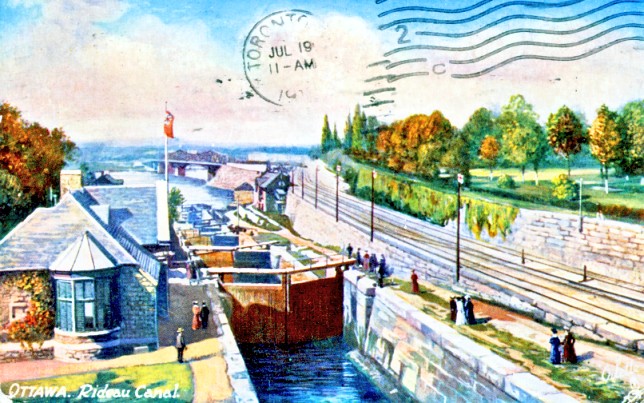
Looking north from the Wellington Street ('Sappers') Bridge
The 'Interprovincial Bridge' to Hull (now Gatineau) was opened around 1901.
Crossing it and then travelling to the picture's right would take a CPR passenger train through Lachute to Montreal.
CPR trains - including the Montreal to Vancouver through trains - finally began using the Union Station above in January 1920.
However, by then ... priority trains were running on a newer faster CPR line from Montreal which went through Vankleek Hill, Ontario.
Ottawa's railway tracks were quite complicated.
Consider this example ...
1. A westbound from Montreal stops at the Union Station on the 'canal side' through tracks with its locomotive facing north.
2. Do you have a headache ?
3. It proceeds away from the camera on the postcard immediately above, and north across to Hull.
4. There it hangs a left and makes a station stop in Hull ... to be polite and inclusive, I guess.
5. It then comes south to Ottawa West ... travelling back across the Ottawa River ... but via ANOTHER BRIDGE.
6. It proceeds west to Vancouver.
2. Do you have a headache ?
3. It proceeds away from the camera on the postcard immediately above, and north across to Hull.
4. There it hangs a left and makes a station stop in Hull ... to be polite and inclusive, I guess.
5. It then comes south to Ottawa West ... travelling back across the Ottawa River ... but via ANOTHER BRIDGE.
6. It proceeds west to Vancouver.
An eastbound from Vancouver to Montreal on the CPR would travel the same circuitous route in the opposite direction.
Why travel to Hull and back ?
Given the station location, the river, the canal, the existing track pattern, and the city's layout ...
this allowed the CPR through train to travel right THROUGH Union Station without having to BACK UP after its stop.
A reverse movement with a long passenger train ... several times each day ... is a complication which is nice to avoid.
Now hold that pose ...
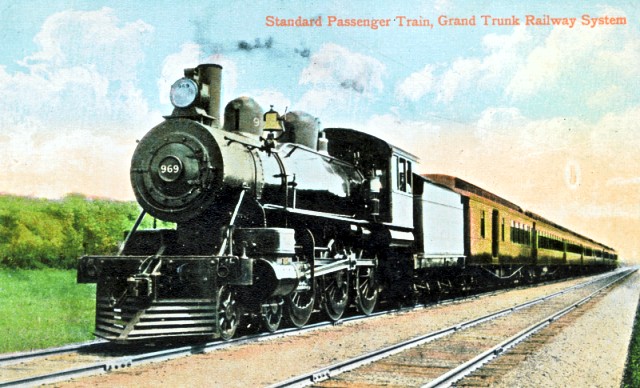
Above you can see a nice shiny Grand Trunk passenger train.
Rods up, counter-weights down on this side for the camera.
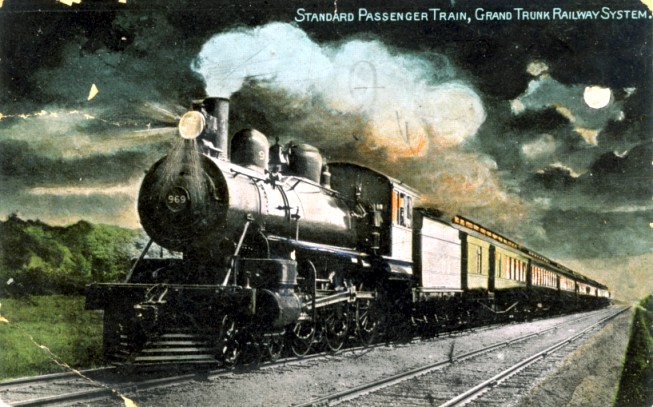
This postcard was mailed from Cardinal, Ontario to Montreal in 1908 ...
and was likely transported on a Grand Trunk train such as this.
Photo doctoring was done by hand in those days long before computers.
You are observing a fairly common postcard artistic technique of the early 1900s - turning day into night.
Back when there was still a Big Hill and a Great Glacier ...
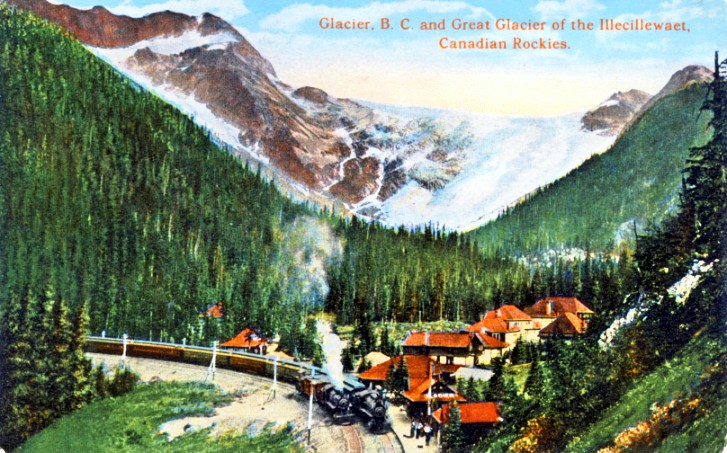
Having just travelled through Rogers Pass, a westbound passenger train arrives at Glacier, British Columbia.
To the east is Golden BC, to the west is Revelstoke BC.
The elusive Rogers Pass through the Selkirk mountain range was essential to the completion of the CPR through the western mountains.
However, with the Rogers Pass line subject to serious avalanches, a more direct and safer route was created with the Connaught Tunnel.
From 1886 until the Connaught Tunnel's 1916 completion, the CPR main line travelled through Glacier, British Columbia just west of the summit at Rogers Pass.
Back in 1890s, a one hour stop for lunch was made here - avoiding the low-revenue tare of a heavy dining car in the mountains.
The Illecillewaet Glacier was just a 15 minute walk away back then.
The Glacier House lodge of the CPR was a secluded mountain resort site on a branch line even after the mainline diversion from Rogers Pass into the Connaught Tunnel.
The lodge was demolished in 1930 and the track was removed.
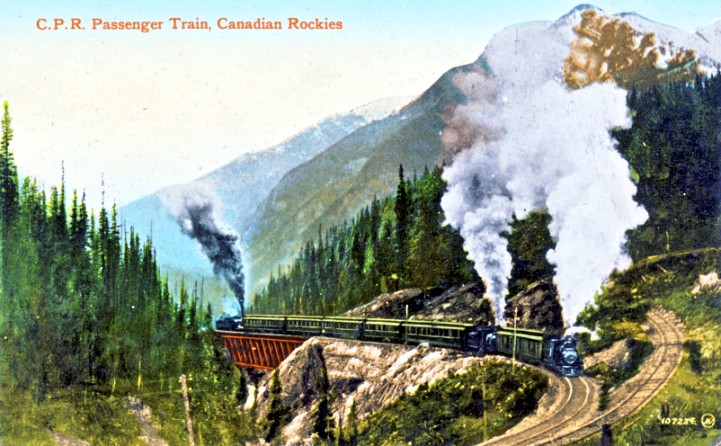
Between 1884 and 1909
(1909 was when the CPR solved 'The Big Hill' problem with the Spiral Tunnels) ...
a portion of the mainline between Calgary and Field, British Columbia travelled on a grade
which was twice the allowable limit of the CPR Contract.
For 4.5 miles, the westbound descent was at a rate of 4.5% ... from Lake Wapta down to Mount Stephen.
Today, the old gradient is used by the Trans-Canada Highway at this point,
and the bridge you see over the Kicking Horse River is preserved with an interpretive plaque.
Here it is taking a special Baldwin pusher and two headend locomotives to get a short passenger train up the grade.
The British postcard artist has colourized the coaches as green instead of CPR's regular maroon shade.
The bridge is maroon instead of black - perhaps to stand out on the postcard.
The track ascending to the right goes nowhere, because ...
Just below the edge of the photo is 'Safety Switch Number 1' which was ALWAYS set for the 'runaway track' to the right.
A descending train had to come to a complete stop before the permanent switch tender was allowed to line the switch for the downhill trip.
There were three such safety switches on the 4.5 mile grade.
'Could I please see your 'Patriotics and Militaria Box?'
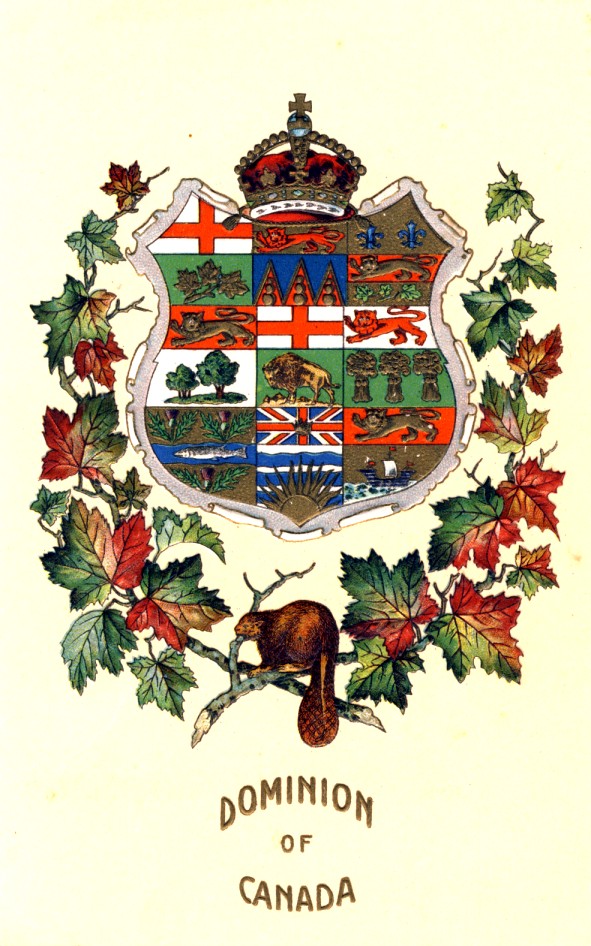
Finally, the crests of Canada's nine provinces are shown on this ornate card en castor.
Back to sitemap